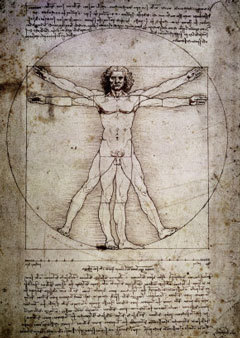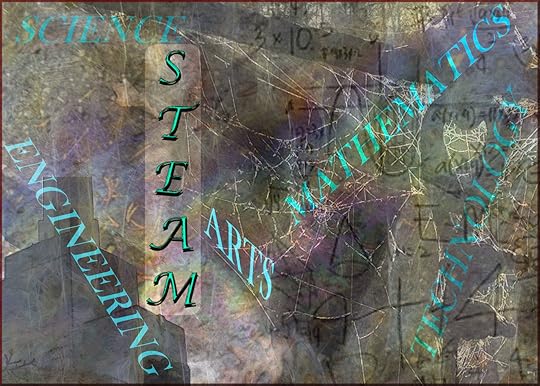Art Lovers discussion
STEAM Power
>
STEAM, not STEM: Science, Tech, Engineering, ARTS, & Math
date newest »
newest »
 newest »
newest »
 We know that "man does not live by bread alone" - that in fact, a life lived entirely in the domain of dry fact and rigorous method without reference to or support from the arts is lacking in colour, warmth, and innovation.
We know that "man does not live by bread alone" - that in fact, a life lived entirely in the domain of dry fact and rigorous method without reference to or support from the arts is lacking in colour, warmth, and innovation. We don't know where the lines are between the domains any longer, however, and this discussion will be aimed at identifying where the (increasingly narrowing) gaps lie, and where the domains overlap and colour one another.
Beginning questions are these:
1. Are there simple, clear, and comprehensive one-sentence definitions of each domain in the STEAM fields? If so, what do you think they look like?
2. Is high-order Mathematics an art or a science?
3. What does pure and applied Science owe to creativity?
4. Can fine art be made of or from Technology?
5. When (if ever) is an Engineer also an artist?
6. Is Art dependent upon good Science, Technology, Engineering and Mathematics (STEM), or is it entirely independent and a domain that can exist without contributions from these other fields?
I will place each question in a separate thread for ease of discussion - please check the threads and respond to the questions there if the topic interests you!
 STEAM not STEM - discussion question 1:
STEAM not STEM - discussion question 1:Are there simple, clear, and comprehensive one-sentence definitions of each domain in the STEAM fields? If so, what do you think they look like?
 STEAM not STEM - discussion question 6:
STEAM not STEM - discussion question 6: Is Art dependent upon good Science, Technology, Engineering and Mathematics (STEM), or is it entirely independent and a domain that can exist without contributions from these other fields?
 Leah wrote: "STEAM not STEM - discussion question 2:
Leah wrote: "STEAM not STEM - discussion question 2: Is high-order Mathematics an art or a science?"
Well, Leah, I wasn't even sure what "high-order" mathematics was so I had to look it up.
I found that they are really related to one another. My first thought when I read this question was Leonardo da Vinci Vitruvian Man. We all know that he was more than just an artist, he was the definition of Renaissance man dipping into all areas. His painting of the proportionate human body was the first clue that makes me think that high-order mathematics is both.
I found this:
"Leonardo’s famous drawings of the Vitruvian proportions of a man’s body first standing inscribed in a square and then with feet and arms outspread inscribed in a circle provides an excellent early example of the way in which his studies of proportion fuse artistic and scientific objectives. It is Leonardo, not Vitruvius, who points out that ‘If you open the legs so as to reduce the stature by one-fourteenth and open and raise your arms so that your middle fingers touch the line through the top of the head, know that the centre of the extremities of the outspread limbs will be the umbilicus, and the space between the legs will make and equilateral triangle’...Here he provides one of his simplest illustrations of a shifting ‘centre of magnitude’ without a corresponding change of ‘centre of normal gravity’. This remains passing through the central line from the pit of the throat through the umbilicus and pubis between the legs. Leonardo repeatedly distinguishes these two different ‘centres’ of a body, i.e., the centers of ‘magnitude’ and ‘gravity"
http://leonardodavinci.stanford.edu/s...

 Leah wrote: "STEAM not STEM - discussion question 3:
Leah wrote: "STEAM not STEM - discussion question 3: What does pure and applied Science owe to creativity?"
I don't know if this is the type of answer you are looking for, or if there is a right or wrong, or even if I understood your question correctly, but when I think of 'pure' science, I think of Biology--flowers, vegetation, etc. and how many artists focus on just these? Or Astronomy--even Vincent van Gogh created Starry Night and to me the essence of the universe is clear. Anatomy would qualify as a science, would it not? And how beautiful is the human body to be re-created in sculpture or painting! I love Michelangelo's David and many of Bernini's works of the body. There are many types of 'pure' science...things that can be studied, identified, quantified, etc. and these things which can be seen, can be created in an art form.
 Leah wrote: "STEAM not STEM - discussion question 2:
Leah wrote: "STEAM not STEM - discussion question 2: Is high-order Mathematics an art or a science?"
Coming back to this question, I remember that Michelangelo's David is a rather large statue. And the pedestal on which he stands is above the viewer's head. For this purpose he deliberately 'adjusted' the proportions of the human body to create the illusion of it being directly proportional from a lower view-point. i.e. his arm holding the rock is longer than a normal arm would be, but seeing it from below, it looks natural.
High-order thinking with mathematics put into art, I believe, is genius!
 Heather wrote: "Leah wrote: "STEAM not STEM - discussion question 2:
Heather wrote: "Leah wrote: "STEAM not STEM - discussion question 2: Is high-order Mathematics an art or a science?"
Well, Leah, I wasn't even sure what "high-order" mathematics was so I had to look it up.
I f..."
Heather, that's a great answer -- when I first heard of and saw the Mandelbrot set of fractal geometry, I began to suspect that mathematics might be one way of creating art. The more I learn about mathematics, art, proportion, shape and form, the more convinced I am that the practice of high order mathematics is a creative act, in part because of the rigorous demand for logic, proofs, and elegance in the solution. But I might be wrong: although your connection of mathematics and art using Da Vinci's illustration gives me a frisson of hope!!
Heather wrote: "Leah wrote: "STEAM not STEM - discussion question 3:
What does pure and applied Science owe to creativity?"
I don't know if this is the type of answer you are looking for, or if there is a right..."
With this question, I'm wondering if the sciences themselves require creative approaches in order to search out hypotheses, establish methods and proofs, and ultimately, to establish solutions to the problems presented to them. I know that the biological, astronomical and material sciences also study objects or living beings that are beautiful in and of themselves, but am curious if others think that sciences are sometimes driven by art rather than the other way around. If anyone has any experience in this area, it is a question that I'm really keen to explore!!
 I'm excited. I got my book in the mail today Proust Was a Neuroscientist by Jonah Lehrer
I'm excited. I got my book in the mail today Proust Was a Neuroscientist by Jonah LehrerIn this technology-driven age, it’s tempting to believe that science can solve every mystery. After all, science has cured countless diseases and even sent humans into space. But as Jonah Lehrer argues in this sparkling debut, science is not the only path to knowledge. In fact, when it comes to understanding the brain, art got there first.
Taking a group of artists — a painter, a poet, a chef, a composer, and a handful of novelists — Lehrer shows how each one discovered an essential truth about the mind that science is only now rediscovering. We learn, for example, how Proust first revealed the fallibility of memory; how George Eliot discovered the brain’s malleability; how the French chef Escoffier discovered umami (the fifth taste); how Cézanne worked out the subtleties of vision; and how Gertrude Stein exposed the deep structure of language — a full half-century before the work of Noam Chomsky and other linguists. It’s the ultimate tale of art trumping science.
More broadly, Lehrer shows that there is a cost to reducing everything to atoms and acronyms and genes. Measurement is not the same as understanding, and art knows this better than science does. An ingenious blend of biography, criticism, and first-rate science writing, Proust Was a Neuroscientist urges science and art to listen more closely to each other, for willing minds can combine the best of both, to brilliant effect.
I've listened to the 7 disk set twice but I don't remember all the facts so I bought the book to actually read and take notes. I guarantee I will have a lot to discuss in this thread. The book speaks of Cezanne, Virginia Woolf, Walt Whitman, and many other artists who learned 'sciences', specifically neuroscience, way before the modern world caught up. They are intricately related! And from what I remember of the disks, it basically nails this topic...at least from the scientific view of neuroscience. I loved it!




Steam Point: A Guide to Integrating Science, Technology, Engineering, the Arts, and Mathematics Through the Common Core
Over the last 60 years, Sciences, Technology, Engineering, Arts and Mathematics (STEAM) have been converging and encroaching on each others domains in intriguing and sometimes unexpected ways.
Today, children must learn a great deal more than ever before about the STEM fields in order to be successful in their careers and endeavors. At the same time, some aspects of the Arts have become hugely technical in ways that have been unexpected and which produce unexpected results.
The Hobbit: Desolation of Smaug movie, for example, employed less than 35 actors -- but during the two years of its making, employed 919 artists of various sorts, most of them working with both high- and low-tech tools.
This discussion is intended to explore the intersections and gaps between Arts and the Sciences, both historically and in contemporary times.
Your thoughts and references are welcome - please have a look at the intro post, and then scroll through the discussion question threads and tell us what you think!